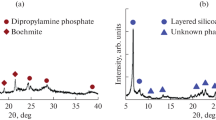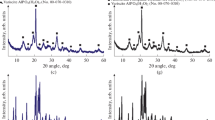Abstract
This work describes how the silica/alumina ratio (SAR) affects the framework, texture, chemical composition, and acidity of SAPO-34 molecular sieves synthesized via hydrothermal crystallization using morpholine (MOR) or triethylamine (TEA) as structure-directing agents (SDA’s). The solids were characterized by X-ray diffraction (XRD), scanning electron microscopy (SEM), N2 adsorption-desorption isotherms, thermogravimetric analysis (TGA), Fourier-transform infrared spectroscopy (FT-IR), X-ray fluorescence spectrometry (XRF), silicon-29 MAS NMR spectroscopy (29Si MAS NMR), aluminum-27 MAS NMR spectroscopy (27Al MAS NMR), and temperature-programmed desorption of ammonia (NH3-TPD). The solids synthesized in this work had crystalline phases, vibrational modes, and morphology characteristics of silicoaluminophosphate (SAPO) materials. Pure SAPO-34 was obtained only with morpholine, while SAPO-18/34 was crystallized with TEA. The SAPO-34 synthesized with MOR had the higher relative crystallinity and incorporation of Si into the framework. The SAPO-18/34 prepared with TEA had the larger surface areas. The solids prepared with SAR 0.3 had only Si(4Al) coordination, independently of the SDA used. The SAPO-34 synthesized with MOR and SAR 0.6 had the highest total acidity (9.75 μmol NH3 m−2).

SAPO molecular sieves were synthesized hydrothermally with different structure-directing agents and silica/alumina ratios. The effects of both variables on the physical and chemical properties of the samples obtained were evaluated. Pure SAPO-34 was obtained with morpholine, while SAPO-18/34 was crystallized with TEA. The SP34T-0.6 sample prepared with triethylamine and SAR 0.6 showed promising characteristics for use as catalyst in MTO reactions: AEI/CHA intergrowths, the lowest acidity, the smallest crystallite size, and a large BET surface area.
Highlights
-
Simultaneous effects of SAR and MOR or TEA on the SAPO-34 properties were studied.
-
SAPO-34 synthesized with morpholine (MOR) had the higher relative crystallinity.
-
AEI/CHA intergrowths were synthesized with triethylamine (TEA) and had the larger surface areas.
-
SAPO prepared with a silica/alumina ratio (SAR) of 0.3 had only the Si(4Al).
-
The SAPO-18/34 synthesized with TEA and SAR 0.6 had the lowest total acidity.






Similar content being viewed by others
Data availability
The data that support the results of this study are available on request to the corresponding author, GPV.
References
Cui Y, Zhang Q, He J, Wang Y, Wei F (2013) Pore-structure-mediated hierarchical SAPO-34. Particuology, https://doi.org/10.1016/j.partic.2012.12.009
Wilson S, Barger P (1999) The characteristics of SAPO-34 which influence the conversion of methanol to light olefins. Microporous Mesoporous Mater, https://doi.org/10.1016/S1387-1811(98)00325-4
Gao B, Fan D, Sun L, An H, Fan F, Xu S, Tian P, Liu Z (2017) Insights into the aminothermal crystallization process of SAPO-34 and its comparison with hydrothermal system. Microporous Mesoporous Mater, https://doi.org/10.1016/j.micromeso.2017.04.035
Pinilla-Herrero I, Olsbye U, Márquez-Álvarez C, Sastre E (2017) Effect of framework topology of SAPO catalysts on selectivity and deactivation profile in the methanol-to-olefins reaction. J Catal, https://doi.org/10.1016/j.jcat.2017.05.008
Wang J, Yang M, Shang W, Su X, Hao Q, Chen H, Ma X (2017) Synthesis, characterization, and catalytic application of hierarchical SAPO-34 zeolite with three-dimensionally ordered mesoporous-imprinted structure. Microporous Mesoporous Mat, https://doi.org/10.1016/j.micromeso.2017.06.012
Zhao D, Zhang Y, Li Z, Wang Y, Yu J (2017) Synthesis of AEI/CHA intergrowth zeolites by dual templates and their catalytic performance for dimethyl ether to olefins. Chem Eng J, https://doi.org/10.1016/j.cej.2017.04.109
Izadbakhsh A, Farhadi F, Khorasheh F, Yan ZF (2009) Effect of heating profile on desorption curve in temperature programmed desorption analysis. J Porous Mater, https://doi.org/10.1007/s10934-008-9237-4
Ye L, Cao F, Ying W, Fang D, Sun Q (2011) Effect of different TEAOH/DEA combinations on SAPO-34’s synthesis and catalytic performance. J Porous Mater, https://doi.org/10.1007/s10934-010-9374-4
Akhgar S, Towfighi J, Hamidzadeh M (2020) A green and cost-effective surfactant-assisted synthesis of SAPO-34 using dual microporous templates with improved performance in MTO reaction. J Sol Gel Sci Technol, https://doi.org/10.1007/s10971-020-05308-w
Bahrami H, Darian JT, Sedighi M (2018) Simultaneous effects of water, TEAOH and morpholine on SAPO 34 synthesis and its performance in MTO process. Microporous Mesoporous Mat, https://doi.org/10.1016/j.micromeso.2017.11.011
Lok BM, Messina CA, Patton RL, Gajek RT, Cannan TR, Flanigen EM (1984) Silicoaluminophosphate molecular sieves. J Am Chem Soc, https://doi.org/10.1021/ja00332a063
Yu T, Fan D, Hao T, Wang J, Shen M, Li W (2014) The effect of various templates on the NH3-SCR activities over Cu/SAPO-34 catalysts. Chem Eng J, https://doi.org/10.1016/j.cej.2014.01.008
Sarkar K, Laha SC, Bhaumik A (2006) A new extra large pore organic-inorganic hybrid silicoaluminophosphate. J Mater Chem, https://doi.org/10.1039/B600989A
Vomscheid R, Briend M, Peltre MJ, Man PP, Barthomeuf D (1994) The role of the template in directing the Si distribution in SAPO zeolites. J Phys Chem, https://doi.org/10.1021/j100089a041
Álvaro-Muñoz T, Márquez-Álvarez C, Sastre E (2012) Use of different templates on SAPO-34 synthesis. Catal Today https://doi.org/10.1016/j.cattod.2011.07.038
Liu G, Tian P, Liu Z (2012) Synthesis of SAPO-34 molecular sieves templated with diethylamine and their properties compared with other templates. Chin J Catal, https://doi.org/10.1016/S1872-2067(10)60325-2
Tan J, Liu Z, Bao X, Liu X, Han X, He C, Zhai R (2002) Crystallization and Si incorporation mechanisms of SAPO-34. Microporous Mesoporous Mat, https://doi.org/10.1016/S1387-1811(02)00329-3
Prakash AM, Unnikrishnan S (1994) Synthesis of SAPO-34. J Chem Soc Faraday Trans, https://doi.org/10.1039/FT9949002291
Xu L, Du A, Wei Y, Wang Y, Yu Z, He Y, Zhang X (2008) Synthesis of SAPO-34 with only Si(4Al) species: effect of Si contents on Si incorporation mechanism and Si coordination environment of SAPO-34. Microporous Mesoporous Mat, https://doi.org/10.1016/j.micromeso.2008.02.001
IZA, International Zeolite Association (2020) Database of zeolite structures. http://www.iza-online.org. Accessed 08 Feb 2021
Lillerud KP, Akporiaye D (1994) Systematic relationships between the structures of CHA, AEI and KFI. Stud Surf Sci Catal, https://doi.org/10.1016/S0167-2991(08)64156-7
Aguayo AT, Gayubo AG, Vivanco R, Olazar M, Bilbao J (2005) Role of acidity and microporous structure in alternative catalysts for the transformation of methanol into olefins. Appl Catal A Gen, https://doi.org/10.1016/j.apcata.2005.01.006
Zhao D, Zhang Y, Li Z, Wang Y, Yu J (2017) Synthesis of SAPO-18/34 intergrowth zeolites and their enhanced stability for dimethyl ether to olefins. RSC Adv, https://doi.org/10.1039/c6ra25080g
Liu G, Tian P, Zhang Y, Li J, Xu L, Meng S, Liu Z (2008) Synthesis of SAPO-34 templated by diethylamine. Microporous Mesoporous Mat, https://doi.org/10.1016/j.micromeso.2008.01.030
Sing KSW, Everett DH, Haul RAW, Moscou L, Pierotti RA, Rouquérol J, Siemieniewska T (1985) Reporting physisorption data for gas/solid systems. Pure Appl Chem, https://doi.org/10.1351/pac198557040603
Breck DW (1974) Zeolite molecular sieve. structure, chemistry, and use. John Wiley & Sons, New York
Ashtekar S, Chilukuri SVV, Chakrabarty DK (1994) Small-pore molecular sieves SAPO-34 and SAPO-44 with chabazite structure. J Phys Chem, https://doi.org/10.1021/j100069a018
Aghamohammadi S, Haghighi M (2015) Dual-template synthesis of nanostructured CoAPSO-34 used in methanol to olefins. Chem Eng J, https://doi.org/10.1016/j.cej.2014.11.102
Wang P, Lv A, Hu J, Xu J, Lu G (2012) The synthesis of SAPO-34 with mixed template and its catalytic performance for methanol to olefins reaction. Microporous Mesoporous Mat, https://doi.org/10.1016/j.micromeso.2011.11.037
Izadbakhsh A, Farhadi F, Khorasheh F, Sahebdelfar S, Asadi M, Yan ZF (2009) Key parameters in hydrothermal synthesis and characterization of low silicon content SAPO-34 molecular sieve. Microporous Mesoporous Mat, https://doi.org/10.1016/j.micromeso.2008.12.009
Blackwell CS, Patton RL (1988) Solid-state NMR of silicoaluminophosphate molecular sieves and aluminophosphate materials. J Phys Chem, https://doi.org/10.1021/j100324a055
Izadbakhsh A, Farhadi F, Khorasheh F, Sahebdelfar S, Asadi M, Feng YZ (2009) Effect of SAPO-34’s composition on its physico-chemical properties and deactivation in MTO process. Appl Catal A Gen, https://doi.org/10.1016/j.apcata.2009.05.022
Dumitriu E, Azzouz A, Hulea V, Lutic D, Kessler H (1997) Synthesis, characterization and catalytic activity of SAPO-34 obtained with piperidine as templating agent. Microporous Mater, https://doi.org/10.1016/S0927-6513(96)00107-1
Acknowledgements
The authors acknowledge the financial support for this research by the Foundation for Research Support of the State of Amazonas (FAPEAM) and the Coordination for the Improvement of Higher Education Personnel (CAPES).
Funding
Foundation for Research Support of the State of Amazonas (FAPEAM) and Coordination for the Improvement of Higher Education Personnel (CAPES).
Author information
Authors and Affiliations
Contributions
WLA and GPV provided the idea for the research. All authors wrote, read, and approved the final manuscript.
Corresponding author
Ethics declarations
Conflict of interest
The authors declare no competing interests.
Additional information
Publisher’s note Springer Nature remains neutral with regard to jurisdictional claims in published maps and institutional affiliations.
Rights and permissions
About this article
Cite this article
dos Anjos, W.L., Morales, S.A.V., Oliveira, N.M.B. et al. Effect of silica/alumina ratio and structure-directing agent on the physical and chemical properties of SAPO-34. J Sol-Gel Sci Technol 100, 466–476 (2021). https://doi.org/10.1007/s10971-021-05669-w
Received:
Accepted:
Published:
Issue Date:
DOI: https://doi.org/10.1007/s10971-021-05669-w




